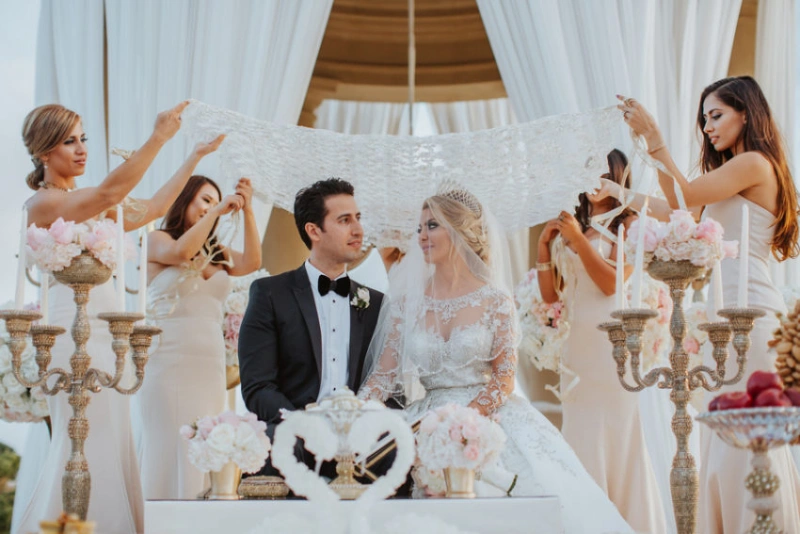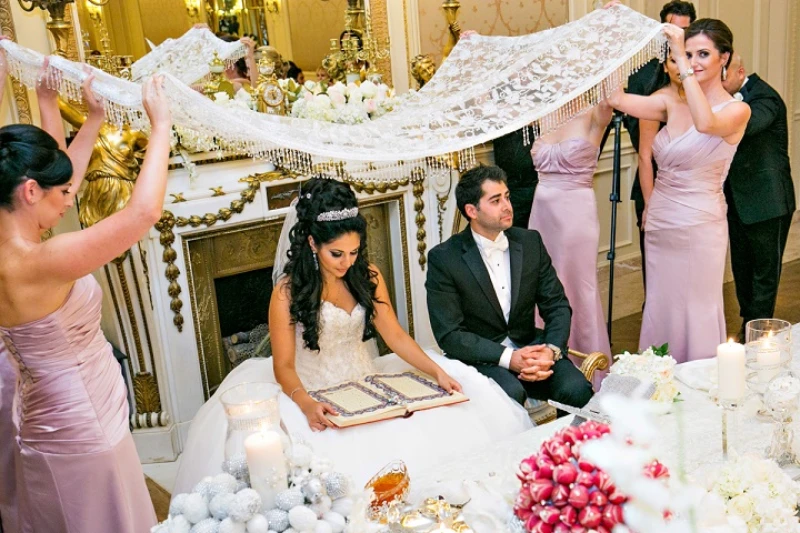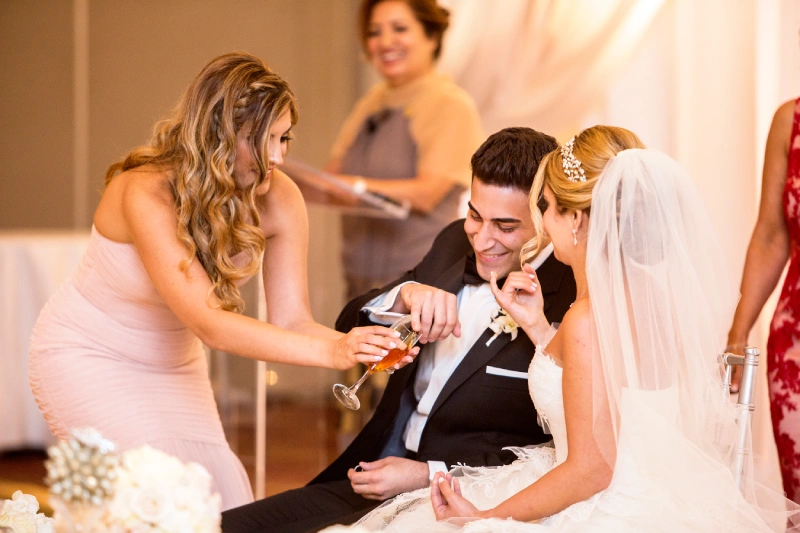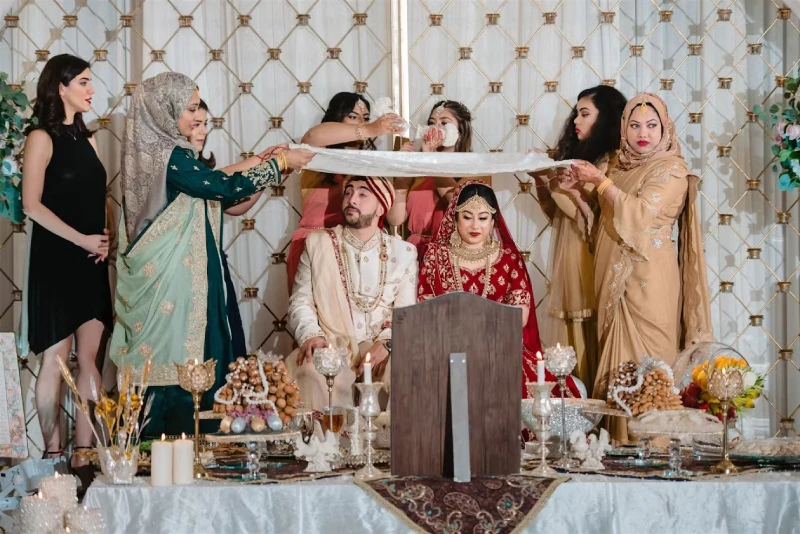Weddings are a celebration of love, culture, and tradition, but they can differ dramatically across the globe. In this article, we delve into the enchanting world of Persian weddings and their Western counterparts, highlighting the key differences that every couple should know. From vibrant ceremonies steeped in history to more understated celebrations symbolizing modern love, each type offers unique rituals and customs that reflect their cultural roots. By exploring aspects such as the significance of family involvement, the richness of traditions, and the iconic elements intertwined in these ceremonies, couples can better appreciate their wedding choices. Join us as we navigate through the beautiful contrasts and help you discover the perfect blend of traditions that can inspire your special day, no matter which path you choose!
Ceremony Structure: Aghd vs Vows and Rings
The heart of every wedding is the ceremony, where two individuals pledge their lives to each other in front of their loved ones. In Persian weddings, this is known as the Aghd, a deeply symbolic and traditional event that can be traced back thousands of years. The Aghd is rich with rituals and customs, often taking place in a beautifully adorned setting. The bride and groom sit at a sofreh, a ceremonial spread laid out with items that symbolize prosperity, health, and happiness. This part of the wedding is not just a legal bond but a deeply spiritual one, involving readings from classical Persian poetry and blessings from elders. The intricate details and significance behind each element reflect the depth of Persian culture and the importance placed on marriage.
In contrast, Western wedding ceremonies can be more straightforward, yet equally meaningful. Typically, they involve the exchange of vows and rings, symbolizing the couple’s commitment to each other. These vows, often personalized, allow couples to express their love and promises in their own words, adding a modern and intimate touch to the ceremony. The exchange of rings serves as a physical representation of their eternal bond. Western ceremonies can be religious or secular, held in various venues such as churches, gardens, or beaches, offering flexibility and personalization to suit the couple’s preferences.
One of the key differences between the Aghd and Western wedding ceremonies is the structure and formality. The Aghd is a more elaborate affair with multiple stages and significant involvement from family and friends, while Western ceremonies, though sometimes elaborate, often focus on the couple’s personal declarations and the symbolic exchange of rings. Both types of ceremonies, despite their differences, aim to highlight the profound commitment and love shared by the couple, making each uniquely special in their own way.
The Role of Family and Guests in Persian vs Western Weddings
Family plays a central role in Persian weddings, with the involvement beginning well before the wedding day. Persian culture places great emphasis on family, and this is reflected in the meticulous planning and execution of the wedding. Parents, grandparents, and extended family members often take on significant roles, from arranging the events to participating in the rituals. During the Aghd, it is common for the couple to seek blessings from their elders, and family members are actively involved in the ceremony, often performing specific tasks and roles. This close-knit involvement reinforces the importance of family unity and support in Persian culture.
Western weddings, on the other hand, tend to focus more on the couple themselves, though family involvement is still significant. Parents usually play key roles, such as walking the bride down the aisle or giving speeches at the reception. However, the planning and decision-making often lie predominantly with the couple. While family and friends are integral to the celebration, the emphasis is on the couple’s wishes and their vision for the wedding. This shift allows for a more personalized approach, where the couple can tailor their day to reflect their individual tastes and preferences.
Guests at Persian weddings can expect to be deeply involved in the celebration, often participating in traditional dances, songs, and rituals. The atmosphere is one of collective joy and festivity, with everyone contributing to the couple’s happiness. In Western weddings, guests typically witness the ceremony and then join the couple for a reception, which may include activities like the first dance, speeches, and cake cutting. While the level of guest involvement may vary, both types of weddings aim to create a memorable experience for everyone in attendance, celebrating the union of the couple with their closest friends and family.
Sofreh Aghd vs Traditional Western Altars
The Sofreh Aghd is a quintessential element of Persian weddings, serving as the focal point of the ceremony. This elaborate spread is meticulously arranged with symbolic items, each representing various aspects of life and marriage. Common elements include a mirror and candles symbolizing light and clarity, a Quran or other holy book reflecting spiritual faith, and herbs and spices representing health and prosperity. The Sofreh Aghd is not only a visual spectacle but a deep-rooted tradition that encapsulates the values and hopes for the couple’s future. The preparation of the Sofreh Aghd is an art form in itself, often involving family members who take pride in creating a beautiful and meaningful display.
In contrast, Western weddings typically feature an altar or an arch as the centerpiece of the ceremony. The altar, often adorned with flowers, fabric, and other decorative elements, serves as the backdrop for the exchange of vows and rings. While the Western altar may not have the same breadth of symbolic items as the Sofreh Aghd, it still carries significant meaning. The altar represents a sacred space where the couple commits to their new life together. The design and decoration of the altar can vary widely, reflecting the couple’s personal style and the overall theme of the wedding.
Despite their differences, both the Sofreh Aghd and the traditional Western altar hold significant importance in their respective ceremonies. They serve as physical embodiments of the couple’s love, commitment, and the cultural values they hold dear. Whether it’s the intricate symbolism of the Sofreh Aghd or the elegant simplicity of a Western altar, these elements contribute to the unique beauty of each wedding, creating a memorable and meaningful experience for the couple and their guests.
Music and Entertainment: Cultural Celebrations Compared
Music and entertainment play a pivotal role in both Persian and Western weddings, though the styles and traditions can differ significantly. Persian weddings are known for their lively and vibrant atmosphere, often featuring traditional Persian music and dance. The music, played by live bands or DJs, includes a mix of classical Persian songs and contemporary hits, creating an energetic and celebratory environment. One of the highlights of a Persian wedding is the traditional dance known as Raghse Chagoo, or the knife dance, where guests take turns dancing with a knife before the cake cutting. This playful and interactive dance adds an element of fun and excitement to the celebration.
Western weddings, while also incorporating music and dance, often feature a blend of genres that reflect the couple’s personal tastes. From classical music during the ceremony to modern hits at the reception, the musical choices are diverse and tailored to the couple’s preferences. A common tradition in Western weddings is the first dance, where the newlyweds share a special moment on the dance floor, often followed by dances with parents and other significant family members. The reception may also include a DJ or live band, providing entertainment and keeping the dance floor lively throughout the night.
Both Persian and Western weddings place a strong emphasis on celebration and joy, with music and dance serving as key elements of the festivities. While the styles and traditions may differ, the underlying goal is the same: to create a memorable and joyous occasion that brings together family and friends in celebration of the couple’s love. Whether it’s the rhythmic beats of Persian drumming or the sweet melodies of a Western love song, music and entertainment are integral parts of the wedding experience, enhancing the overall atmosphere and creating lasting memories for everyone involved.
Fashion Differences Between Persian and Western Bridal Styles
Fashion is a significant aspect of any wedding, and the differences between Persian and Western bridal styles are both fascinating and beautiful. Persian brides often wear elaborate and ornate gowns, reflecting the opulence and grandeur associated with Persian culture. These dresses are typically adorned with intricate embroidery, beadwork, and luxurious fabrics such as silk and satin. The color palette can vary, with some brides opting for traditional white while others choose vibrant colors that signify joy and celebration. In addition to the gown, Persian brides often wear elaborate jewelry and headpieces, adding to the overall regal appearance.
Western bridal fashion, while also elegant and sophisticated, tends to focus on simplicity and modernity. The classic white wedding dress remains a popular choice, symbolizing purity and new beginnings. Western bridal gowns come in a variety of styles, from ball gowns and A-line dresses to sleek, minimalist designs. The focus is often on clean lines, delicate lace, and subtle embellishments, creating a timeless and elegant look. Accessories such as veils, tiaras, and jewelry are chosen to complement the dress, adding a touch of personal style and elegance.
The groom’s attire in both cultures also reflects these stylistic differences. Persian grooms often wear tailored suits or traditional garments that match the bride’s opulence, complete with intricate details and luxurious fabrics. Western grooms typically opt for classic tuxedos or suits, focusing on a sleek and polished appearance. The choice of attire for both the bride and groom is a reflection of their cultural heritage and personal style, contributing to the overall aesthetic and feel of the wedding.
Fashion at weddings is not just about looking good; it’s about expressing cultural identity and personal taste. Whether it’s the elaborate and ornate style of Persian bridal fashion or the elegant simplicity of Western bridal gowns, each style tells a unique story. The careful selection of attire for the bride and groom is a testament to the importance of tradition, culture, and individual expression, making each wedding a truly unique and memorable event.
Reception Traditions: From Knife Dances to First Dances
Reception traditions are a highlight of any wedding, offering a chance for couples and their guests to celebrate and enjoy the festivities. Persian weddings are renowned for their vibrant and interactive reception traditions, one of the most famous being the knife dance, or Raghse Chagoo. During this playful dance, guests take turns dancing with a knife before passing it to the next person, all while the bride and groom attempt to “bribe” the dancer to hand over the knife for the cake cutting. This tradition not only adds a fun and lighthearted element to the reception but also encourages participation and interaction among guests, creating a lively and festive atmosphere.
Western weddings, while also rich in tradition, often feature the iconic first dance as a central element of the reception. The first dance is a poignant moment where the newlyweds share a special dance, often to a song that holds personal significance. This tradition symbolizes the couple’s first steps together as a married pair, setting the tone for the celebration to follow. In addition to the first dance, Western receptions may include other dances such as the father-daughter dance and the mother-son dance, each carrying its own emotional and symbolic weight.
Both Persian and Western wedding receptions are designed to be joyous and celebratory, but they differ in their approach and traditions. Persian receptions are often characterized by their energetic and festive nature, with music, dance, and interactive rituals playing a central role. Western receptions, while also celebratory, tend to focus on meaningful moments and personal touches, such as heartfelt speeches, toasts, and special dances. Despite these differences, the underlying purpose of both types of receptions is the same: to celebrate the union of the couple with their loved ones, creating lasting memories and joyous moments for everyone involved.
Food and Catering: Persian Feasts vs Western Menus
Food is a central component of any wedding celebration, and the culinary offerings at Persian and Western weddings reflect the rich cultural heritage and traditions of each. Persian weddings are renowned for their lavish feasts, featuring a diverse array of dishes that showcase the flavors and culinary traditions of Persian cuisine. A typical Persian wedding menu may include a variety of kebabs, rice dishes such as saffron-infused basmati rice and jeweled rice, stews, salads, and an assortment of appetizers and desserts. The emphasis is on abundance and variety, with guests treated to a sumptuous spread that highlights the richness and diversity of Persian cuisine.
Western wedding menus, on the other hand, often focus on a more structured and formal dining experience. The meal typically consists of multiple courses, including appetizers, a main course, and dessert. While the specific dishes can vary widely depending on the couple’s preferences and regional influences, common options include dishes such as roasted meats, seafood, pasta, and fresh salads. Western weddings often offer a choice of entrees to accommodate different dietary preferences, and the meal is usually accompanied by a selection of wines and other beverages. Dessert often features a wedding cake, which is ceremonially cut by the bride and groom and served to the guests.
Both Persian and Western wedding feasts are designed to be memorable and enjoyable, but they differ in their approach and presentation. Persian wedding feasts are often served buffet-style, allowing guests to sample a variety of dishes and savor the diverse flavors of Persian cuisine. The focus is on abundance and communal dining, with guests encouraged to indulge and celebrate together. In contrast, Western wedding meals are typically served as a plated dinner, with each course carefully curated and presented. The formal dining experience adds a touch of elegance and sophistication, creating a refined and memorable culinary experience for the guests.
The food and catering choices at a wedding are a reflection of the couple’s cultural heritage, personal preferences, and the overall theme of the celebration. Whether it’s the lavish and abundant feast of a Persian wedding or the elegant and structured dining experience of a Western wedding, the culinary offerings play a crucial role in creating a memorable and enjoyable celebration for the couple and their guests.
Symbolism and Rituals Unique to Each Culture
Symbolism and rituals are integral to both Persian and Western weddings, each carrying deep cultural significance and meaning. Persian weddings are steeped in symbolism, with many of the rituals and customs reflecting the values and beliefs of Persian culture. One of the most significant rituals is the Sofreh Aghd, a ceremonial spread laid out with items that symbolize prosperity, health, and happiness. The mirror and candles represent light and clarity, while the herbs and spices signify health and vitality. Another important ritual is the exchange of honey, where the bride and groom dip their fingers in honey and feed it to each other, symbolizing sweetness and harmony in their marriage.
Western weddings also feature a variety of symbolic rituals, each reflecting the cultural and religious traditions of the couple. One of the most iconic symbols is the exchange of wedding rings, representing eternal love and commitment. The unity candle ceremony is another common ritual, where the bride and groom each light a candle and then use them to light a single, larger candle, symbolizing the joining of their lives and families. Other rituals may include the breaking of a glass in Jewish weddings, symbolizing the fragility of human relationships, or the handfasting ceremony in Celtic traditions, where the couple’s hands are tied together with a ribbon to symbolize their union.
Despite the differences in their specific rituals and symbols, both Persian and Western weddings share a common goal: to celebrate the union of the couple and to wish them a happy and prosperous future. The rituals and symbols used in each type of wedding are a reflection of the cultural heritage and values of the couple, adding depth and meaning to the celebration. Whether it’s the intricate symbolism of a Persian wedding or the timeless rituals of a Western wedding, these traditions play a crucial role in creating a memorable and meaningful experience for the couple and their guests.
The rich tapestry of rituals and symbols in both Persian and Western weddings highlights the importance of cultural heritage and tradition in the celebration of marriage. These rituals not only add beauty and significance to the wedding but also serve as a reminder of the values and beliefs that the couple holds dear. By incorporating these traditions into their wedding, couples can honor their cultural roots and create a celebration that is uniquely their own.
Conclusion: Embracing Cultural Diversity in Weddings
As we have explored, Persian and Western weddings each offer a unique set of traditions, rituals, and customs that reflect their respective cultural heritages. From the elaborate and symbolic Sofreh Aghd to the personalized vows and ring exchanges, each type of wedding provides a rich and meaningful way to celebrate the union of two individuals. The differences in ceremony structure, family involvement, fashion, music, entertainment, food, and symbolism highlight the diverse ways in which love and commitment are honored across cultures.
Embracing cultural diversity in weddings allows couples to create a celebration that is truly reflective of their identities and values. By incorporating elements from both Persian and Western traditions, couples can design a wedding that honors their cultural heritage while also expressing their personal style and preferences. This blending of traditions can result in a unique and memorable celebration that brings together the best of both worlds, creating a rich tapestry of rituals and customs that celebrate the couple’s love and commitment.
Ultimately, the beauty of weddings lies in their ability to bring people together in celebration of love, regardless of cultural differences. By understanding and appreciating the unique traditions and customs of Persian and Western weddings, couples can create a wedding that is not only meaningful and memorable but also a true reflection of their shared journey and the diverse world in which we live. Whether you choose a traditional Persian wedding, a classic Western ceremony, or a blend of both, the most important thing is to celebrate your love in a way that feels authentic and true to you.




